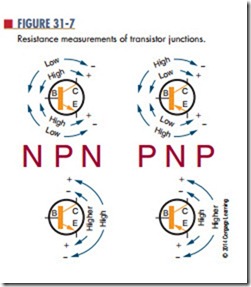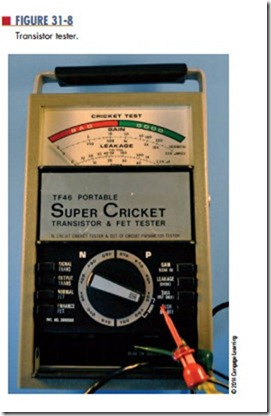Transistor Testing
Transistors are semiconductor devices that usually operate for long periods of time without failure. If a transistor does fail, excessively high temperature, current, or voltage generally causes the failure. Failure can also be caused by extreme mechanical stress. As a result of this electrical or mechanical abuse, a transistor may open or short internally, or its characteristics may alter enough to affect its operation. There are two methods for checking a transistor to determine whether it is functioning properly: with an ohmmeter and with a transistor tester.
A conventional ohmmeter can help detect a defective transistor in an out-of-circuit test. Resistance tests are made between the two junctions of a transistor in the following way: emitter to base, collector to base, and collector to emitter. In testing the transistor, the resistance is measured between any two terminals with the meter leads connected one way. The meter leads are then reversed. In one-meter connection, the resistance should be high, 10,000 ohms or more. In the other meter connection, the resistance should be lower, less than 10,000 ohms.
Each junction of a transistor exhibits a low resistance when it is forward biased and a high resistance when reverse biased. The battery in the ohmmeter is the source of the forward- and reverse-bias voltage. The exact resistance measured varies with different types of transistors, but there is always a change
when the ohmmeter leads are reversed. This method of checking works for either NPN or PNP transistors (Figure 31-7).
If a transistor fails this test, it is defective. If it passes, it may still be defective. A more reliable means of testing a transistor is by using a transistor tester.
Transistor testers are designed specifically for testing transistors and diodes. There are two types: an in-circuit tester and an out-of-circuit tester. Both may be housed in the same package (Figure 31-8).
C a u T i o n !
As with diodes, the ohmmeter terminal voltage must never exceed the maximum voltage rating between the junctions of a transistor. The lower scales of some ohmmeters can supply a damaging current to the transistor under test. As a precautionary measure, it is best to start out at the safest range and then change to a scale that gives an adequate reading.
The transistor’s ability to amplify is taken as a rough measure of its performance. There is an advantage with an in-circuit tester because the transistor does not have to be removed from the circuit. Not only can an out-of-circuit transistor tester determine
whether the transistor is good or defective, it can also determine the leakage current.
Transistor testers contain controls for adjusting voltage, current, and signal. Refer to the manufacturer’s instruction manual for the proper settings.
Questions
1. What may cause a transistor to fail?
2. What are two methods of testing a transistor?
3. When using an ohmmeter, what should the results be for an NPN transistor?
4. What caution must be observed when checking a transistor with an ohmmeter?
5. What are the two types of commercial transistor testers?

